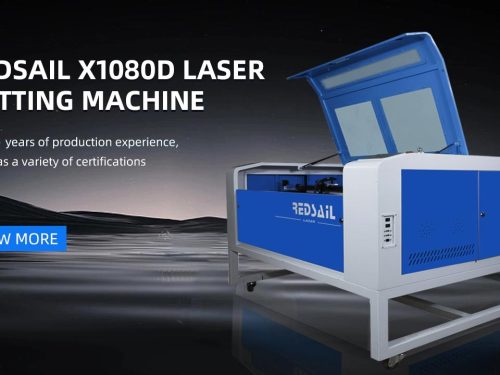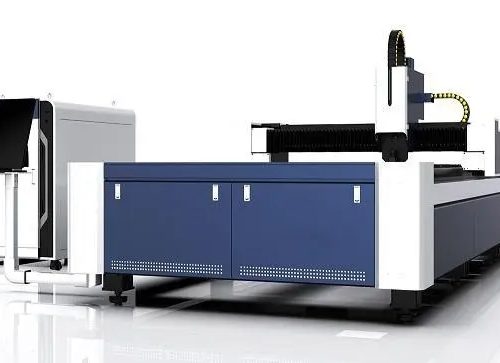
Laser cutting is one of the thermal cutting methods, which uses the focused high-power density laser beam to irradiate the workpiece, so that the irradiated material can quickly melt, vaporize, ablate or reach the ignition point, and at the same time, the molten material can be blown away by the high-speed airflow coaxial with the beam, so as to cut the workpiece.
1、 Application of laser cutting
Most laser cutting machines are controlled by numerical control programs or made into cutting robots. As a precise machining method, laser cutting can cut almost all materials, including two-dimensional cutting or three-dimensional cutting of thin metal plates.
In the field of automobile manufacturing, the cutting technology of spatial curves such as car roof windows has been widely used. Volkswagen of Germany uses a laser with a power of 500W to cut complex shaped body sheets and various curved surfaces. In the aerospace field, laser cutting technology is mainly used for cutting special aerospace materials, such as titanium alloy, aluminum alloy, nickel alloy, chromium alloy, stainless steel, beryllium oxide, composite materials, plastics, ceramics and quartz. Aerospace components processed by laser cutting include engine flame barrel, titanium alloy thin-wall casing, aircraft frame, titanium alloy skin, wing truss, tail wing wall panel, helicopter main rotor, and space shuttle ceramic insulation tile.
Laser cutting technology is also widely used in the field of non-metallic materials. It can not only cut materials with high hardness and brittleness, such as silicon nitride, ceramics, quartz, etc; It can also cut and process flexible materials, such as cloth, paper, plastic plate, rubber, etc. if laser is used for garment cutting, it can save 10% ~ 12% of clothing materials and improve the efficiency by more than 3 times.
2、 Laser cutting materials
- Structural steel
When the material is cut with oxygen, better results will be obtained. When oxygen is used as the processing gas, the cutting edge will be slightly oxidized. For plates with a thickness of 4mm, nitrogen can be used as the processing gas for high-pressure cutting. In this case, the cut edge will not be oxidized. For plates with a thickness of more than 10mm, the use of special plates for lasers and the application of oil to the surface of workpieces during processing can achieve better results. - Stainless steel
Oxygen can be used when oxidation of the cutting end face is acceptable; Nitrogen is used to obtain edges without oxidation and burr, so no further treatment is required. Coating the oil film on the surface of the plate will get a better perforation effect without reducing the processing quality. - Aluminum
With high reflectivity and thermal conductivity, aluminum materials with a thickness of less than 6mm can be cut, depending on the alloy type and laser capacity. When oxygen is used for cutting, the cutting surface is rough and hard. When nitrogen is used, the cutting surface is smooth. Pure aluminum is very difficult to cut because of its high purity. Only when the system is equipped with a “reflection absorption” device can it be cut. Otherwise reflection will destroy the optical components. - Titanium
Titanium plates are cut with argon and nitrogen as processing gases. Other parameters can refer to nickel chromium steel. - Copper and brass
Both materials have high reflectivity and very good thermal conductivity. Brass with thickness less than 1mm can be cut with nitrogen; Copper with a thickness of less than 2mm can be cut, and the processing gas must be oxygen. Copper and brass can be cut only when a “reflection absorption” device is installed on the system. Otherwise reflection will destroy the optical components.
3、 Calculation method of processing cost of laser cutting machine
For those who are first in contact with laser cutting and processing products, it is a headache to calculate their processing fees. If the manufacturer directly quotes, they always feel high and reluctant to pay. Let them calculate by themselves. They don’t have a standard to measure, because they don’t know whether this price is the real price. Just recognize the manufacturer of laser cutting and processing, and today Xiaobian helps you solve this problem, Teach you how to calculate the cost of laser cutting.
Laser cutting processing is settled by hour and has regional differences:
Generally, it ranges from 400 to 1000 per hour, and regional differences are also relatively large. It is cheaper in Hefei, Zhejiang and Shenzhen; Beijing, Shanghai, Chongqing and other places are relatively expensive.
This is obviously different from your region. Because the prices of sheet metal materials and labor costs in your region are different, the quotation will also be different, but the price fluctuation is definitely within this range, but beyond this range.
Calculation multiple relationship of laser cutting cost
When calculating the cost, many companies do not necessarily calculate according to the laser cutting process, but quote according to the length of the cutting line. The carbon steel plate is generally 1.5 times the plate thickness per meter, that is to say, the cutting cost per meter of 4mm carbon steel plate = 4 * 1.5 = 6 yuan / meter.
The algorithm on the market price is generally: the price of cutting one meter = the plate thickness of the material to be cut × 1.5 (price excluding material cost, processing with materials by customers)
Example:
The price of laser cutting one meter of 6 mm low-carbon steel plate is: 6 (plate thickness) × 1.5 = 9 yuan / meter
The price of one meter of 10mm low carbon steel laser cutting is: 10 (plate thickness) × 1.5 = 15 yuan / meter
The price of one meter of 12mm low carbon steel laser cutting is: 12 (plate thickness) × 1.5 = 18 yuan / meter
According to this formula, the price of one meter of cutting with different thickness can be obtained.
The price per meter of stainless steel is generally 2.5 times of the plate thickness, and the price per meter of aluminum plate is generally 4 times of the plate thickness.
At the same time, if a hole is to be cut in the middle of the plate, a perforation fee will be charged, which generally ranges from 0.4 to 2 yuan according to the thickness of the plate.
Some companies also need to operate empty, generally multiplying the total price by 1.2 times. Some companies do not accept empty, and the price of large quantities can be cheaper.
Of course, the specific price has a lot to do with the size of the processing volume, the shape of the parts (if it is all small holes, it cannot be calculated in meters), whether it includes freight, whether it is processed with materials, and so on. Therefore, general factories or processing plants will fluctuate and will be automatically measured according to the quantity.










